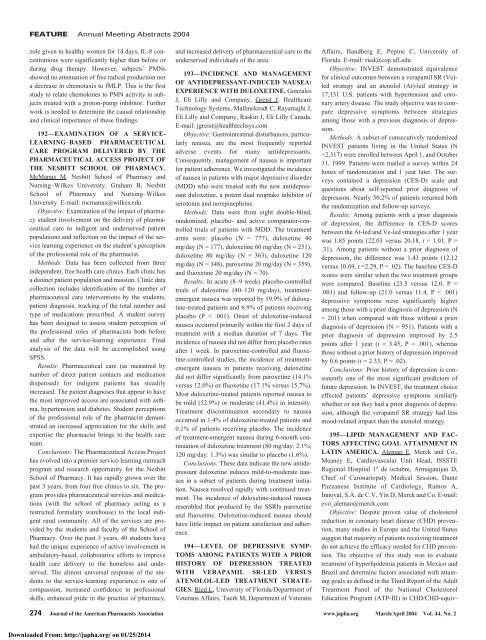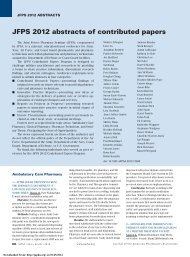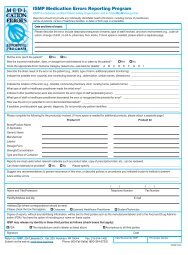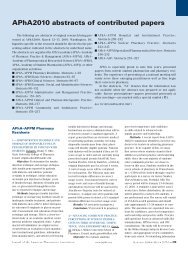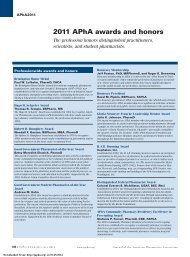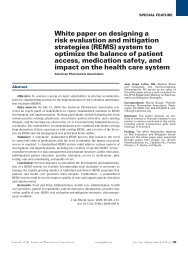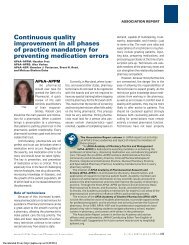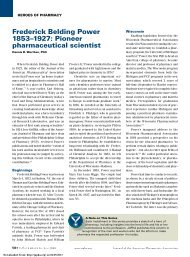Downloaded - Journal of American Pharmacists Association
Downloaded - Journal of American Pharmacists Association
Downloaded - Journal of American Pharmacists Association
Create successful ePaper yourself
Turn your PDF publications into a flip-book with our unique Google optimized e-Paper software.
FEATURE Annual Meeting Abstracts 2004<br />
zole given to healthy women for 14 days, IL-8 concentrations<br />
were significantly higher than before or<br />
during drug therapy. However, subjects’ PMNs<br />
showed no attenuation <strong>of</strong> free radical production nor<br />
a decrease in chemotaxis to fMLP. This is the first<br />
study to relate chemokines to PMN activity in subjects<br />
treated with a proton-pump inhibitor. Further<br />
work is needed to determine the causal relationship<br />
and clinical importance <strong>of</strong> these findings.<br />
192—EXAMINATION OF A SERVICE-<br />
LEARNING–BASED PHARMACEUTICAL<br />
CARE PROGRAM DELIVERED BY THE<br />
PHARMACEUTICAL ACCESS PROJECT OF<br />
THE NESBITT SCHOOL OF PHARMACY.<br />
McManus M, Nesbitt School <strong>of</strong> Pharmacy and<br />
Nursing–Wilkes University, Graham B, Nesbitt<br />
School <strong>of</strong> Pharmacy and Nursing–Wilkes<br />
University. E-mail: mcmanus@wilkes.edu<br />
Objective: Examination <strong>of</strong> the impact <strong>of</strong> pharmacy<br />
student involvement on the delivery <strong>of</strong> pharmaceutical<br />
care to indigent and underserved patient<br />
populations and reflection on the impact <strong>of</strong> the service<br />
learning experience on the student’s perception<br />
<strong>of</strong> the pr<strong>of</strong>essional role <strong>of</strong> the pharmacist.<br />
Methods: Data has been collected from three<br />
independent, free health care clinics. Each clinic has<br />
a distinct patient population and mission. Clinic data<br />
collection includes identification <strong>of</strong> the number <strong>of</strong><br />
pharmaceutical care interventions by the students,<br />
patient diagnosis, tracking <strong>of</strong> the total number and<br />
type <strong>of</strong> medications prescribed. A student survey<br />
has been designed to assess student perception <strong>of</strong><br />
the pr<strong>of</strong>essional roles <strong>of</strong> pharmacists both before<br />
and after the service-learning experience. Final<br />
analysis <strong>of</strong> the data will be accomplished using<br />
SPSS.<br />
Results: Pharmaceutical care (as measured by<br />
number <strong>of</strong> direct patient contacts and medication<br />
dispensed) for indigent patients has steadily<br />
increased. The patient diagnoses that appear to have<br />
the most improved access are associated with asthma,<br />
hypertension and diabetes. Student perceptions<br />
<strong>of</strong> the pr<strong>of</strong>essional role <strong>of</strong> the pharmacist demonstrated<br />
an increased appreciation for the skills and<br />
expertise the pharmacist brings to the health care<br />
team.<br />
Conclusions: The Pharmaceutical Access Project<br />
has evolved into a premier service-learning outreach<br />
program and research opportunity for the Nesbitt<br />
School <strong>of</strong> Pharmacy. It has rapidly grown over the<br />
past 3 years, from four free clinics to six. The program<br />
provides pharmaceutical services and medications<br />
(with the school <strong>of</strong> pharmacy acting as a<br />
restricted formulary warehouse) to the local indigent<br />
rural community. All <strong>of</strong> the services are provided<br />
by the students and faculty <strong>of</strong> the School <strong>of</strong><br />
Pharmacy. Over the past 3 years, 40 students have<br />
had the unique experience <strong>of</strong> active involvement in<br />
ambulatory-based, collaborative efforts to improve<br />
health care delivery to the homeless and undeserved.<br />
The almost universal response <strong>of</strong> the students<br />
to the service-learning experience is one <strong>of</strong><br />
compassion, increased confidence in pr<strong>of</strong>essional<br />
skills, enhanced pride in the practice <strong>of</strong> pharmacy,<br />
and increased delivery <strong>of</strong> pharmaceutical care to the<br />
underserved individuals <strong>of</strong> the area.<br />
193—INCIDENCE AND MANAGEMENT<br />
OF ANTIDEPRESSANT-INDUCED NAUSEA:<br />
EXPERIENCE WITH DULOXETINE. Gonzales<br />
J, Eli Lilly and Company, Greist J, Healthcare<br />
Technology Systems, Mallinckrodt C, Rayamajhi J,<br />
Eli Lilly and Company, Raskin J, Eli Lilly Canada.<br />
E-mail: jgreist@healthtechsys.com<br />
Objective: Gastrointestinal disturbances, particularly<br />
nausea, are the most frequently reported<br />
adverse events for many antidepressants.<br />
Consequently, management <strong>of</strong> nausea is important<br />
for patient adherence. We investigated the incidence<br />
<strong>of</strong> nausea in patients with major depressive disorder<br />
(MDD) who were treated with the new antidepressant<br />
duloxetine, a potent dual reuptake inhibitor <strong>of</strong><br />
serotonin and norepinephrine.<br />
Methods: Data were from eight double-blind,<br />
randomized, placebo- and active comparator-controlled<br />
trials <strong>of</strong> patients with MDD. The treatment<br />
arms were: placebo (N = 777), duloxetine 40<br />
mg/day (N = 177), duloxetine 60 mg/day (N = 251),<br />
duloxetine 80 mg/day (N = 363), duloxetine 120<br />
mg/day (N = 348), paroxetine 20 mg/day (N = 359),<br />
and fluoxetine 20 mg/day (N = 70).<br />
Results: In acute (8–9 week) placebo-controlled<br />
trials <strong>of</strong> duloxetine (40–120 mg/day), treatmentemergent<br />
nausea was reported by 19.9% <strong>of</strong> duloxetine-treated<br />
patients and 6.9% <strong>of</strong> patients receiving<br />
placebo (P < .001). Onset <strong>of</strong> duloxetine-induced<br />
nausea occurred primarily within the first 2 days <strong>of</strong><br />
treatment with a median duration <strong>of</strong> 7 days. The<br />
incidence <strong>of</strong> nausea did not differ from placebo rates<br />
after 1 week. In paroxetine-controlled and fluoxetine-controlled<br />
studies, the incidence <strong>of</strong> treatmentemergent<br />
nausea in patients receiving duloxetine<br />
did not differ significantly from paroxetine (14.1%<br />
versus 12.0%) or fluoxetine (17.1% versus 15.7%).<br />
Most duloxetine-treated patients reported nausea to<br />
be mild (52.9%) or moderate (41.4%) in intensity.<br />
Treatment discontinuation secondary to nausea<br />
occurred in 1.4% <strong>of</strong> duloxetine-treated patients and<br />
0.1% <strong>of</strong> patients receiving placebo. The incidence<br />
<strong>of</strong> treatment-emergent nausea during 6-month continuation<br />
<strong>of</strong> duloxetine treatment (80 mg/day: 2.1%;<br />
120 mg/day: 1.3%) was similar to placebo (1.6%).<br />
Conclusions: These data indicate the new antidepressant<br />
duloxetine induces mild-to-moderate nausea<br />
in a subset <strong>of</strong> patients during treatment initiation.<br />
Nausea resolved rapidly with continued treatment.<br />
The incidence <strong>of</strong> duloxetine-induced nausea<br />
resembled that produced by the SSRIs paroxetine<br />
and fluoxetine. Duloxetine-induced nausea should<br />
have little impact on patient satisfaction and adherence.<br />
194—LEVEL OF DEPRESSIVE SYMP-<br />
TOMS AMONG PATIENTS WITH A PRIOR<br />
HISTORY OF DEPRESSION TREATED<br />
WITH VERAPAMIL SR-LED VERSUS<br />
ATENOLOL-LED TREATMENT STRATE-<br />
GIES. Ried L, University <strong>of</strong> Florida/Department <strong>of</strong><br />
Veterans Affairs, Tueth M, Department <strong>of</strong> Veterans<br />
Affairs, Handberg E, Pepine C, University <strong>of</strong><br />
Florida. E-mail: ried@cop.ufl.edu<br />
Objective: INVEST demonstrated equivalence<br />
for clinical outcomes between a verapamil SR (Ve)-<br />
led strategy and an atenolol (At)-led strategy in<br />
17,131 U.S. patients with hypertension and coronary<br />
artery disease. The study objective was to compare<br />
depressive symptoms between strategies<br />
among those with a previous diagnosis <strong>of</strong> depression.<br />
Methods: A subset <strong>of</strong> consecutively randomized<br />
INVEST patients living in the United States (N<br />
=2,317) were enrolled between April 1, and October<br />
31, 1999. Patients were mailed a survey within 24<br />
hours <strong>of</strong> randomization and 1 year later. The surveys<br />
contained a depression (CES-D) scale and<br />
questions about self-reported prior diagnosis <strong>of</strong><br />
depression. Nearly 50.2% <strong>of</strong> patients returned both<br />
the randomization and follow-up surveys.<br />
Results: Among patients with a prior diagnosis<br />
<strong>of</strong> depression, the difference in CES-D scores<br />
between the At-led and Ve-led strategies after 1 year<br />
was 1.85 points (22.03 versus 20.18, t = 1.01, P =<br />
.31). Among patients without a prior diagnosis <strong>of</strong><br />
depression, the difference was 1.43 points (12.12<br />
versus 10.69, t =2.29, P = .02). The baseline CES-D<br />
scores were similar when the two treatment groups<br />
were compared. Baseline (23.5 versus 12.0, P <<br />
.001) and follow-up (21.0 versus 11.4, P < .001)<br />
depressive symptoms were significantly higher<br />
among those with a prior diagnosis <strong>of</strong> depression (N<br />
= 201) when compared with those without a prior<br />
diagnosis <strong>of</strong> depression (N = 951). Patients with a<br />
prior diagnosis <strong>of</strong> depression improved by 2.5<br />
points after 1 year (t = 3.45, P = .001), whereas<br />
those without a prior history <strong>of</strong> depression improved<br />
by 0.6 points (t = 2.33, P = .02).<br />
Conclusions: Prior history <strong>of</strong> depression is consistently<br />
one <strong>of</strong> the most significant predictors <strong>of</strong><br />
future depression. In INVEST, the treatment choice<br />
effected patients’ depressive symptoms similarly<br />
whether or not they had a prior diagnosis <strong>of</strong> depression,<br />
although the verapamil SR strategy had less<br />
mood-related impact than the atenolol strategy.<br />
195—LIPID MANAGEMENT AND FAC-<br />
TORS AFFECTING GOAL ATTAINMENT IN<br />
LATIN AMERICA. Alemao E, Merck and Co.,<br />
Meaney E, Cardiovascular Unit Head, ISSSTE<br />
Regional Hospital 1º de octubre, Armaganijan D,<br />
Chief <strong>of</strong> Caronariopaty Medical Session, Dante<br />
Pazzanese Institute <strong>of</strong> Cardiology, Ramos A,<br />
Innoval, S.A. de C.V, Yin D, Merck and Co. E-mail:<br />
evo_alemao@merck.com<br />
Objective: Despite proven value <strong>of</strong> cholesterol<br />
reduction in coronary heart disease (CHD) prevention,<br />
many studies in Europe and the United States<br />
suggest that majority <strong>of</strong> patients receiving treatment<br />
do not achieve the efficacy needed for CHD prevention.<br />
The objective <strong>of</strong> this study was to evaluate<br />
treatment <strong>of</strong> hyperlipidemia patients in Mexico and<br />
Brazil and determine factors associated with attaining<br />
goals as defined in the Third Report <strong>of</strong> the Adult<br />
Treatment Panel <strong>of</strong> the National Cholesterol<br />
Education Program (ATP-III) in CHD/CHD-equiv-<br />
274 <strong>Journal</strong> <strong>of</strong> the <strong>American</strong> <strong>Pharmacists</strong> <strong>Association</strong> www.japha.org March/April 2004 Vol. 44, No. 2<br />
<strong>Downloaded</strong> From: http://japha.org/ on 01/25/2014


